Research on Ecological Landscape Design and Healing Effect Based on 3D Roaming Technology
Abstract
:1. Introduction
2. Materials and Methods
2.1. Study Area
2.2. Quantity Collection and Processing
2.2.1. Data Collection
2.2.2. Scene Construction
2.2.3. VR and Skin Electricity Experiment
2.3. Data Visualization
2.3.1. Visualization of Interest Experience
2.3.2. Correlation Analysis of Interest and Emotional Arousal
2.3.3. Analysis of Healing Effect
2.4. Technical Framework Diagram
3. Results
3.1. The Change Trend of Interest and Heat Map Confirmed That the Subjects Experienced High Interest in the Immersive Experience
3.2. Positive Emotional Arousal State of Subjects after Immersive Experience of 3D Roaming Landscape Scene
3.3. The SC Fluctuation Variance of the Subjects Was Low after the Immersion Experience, Which Confirmed That the Healing Effect Was Significant
4. Conclusions
Author Contributions
Funding
Institutional Review Board Statement
Informed Consent Statement
Data Availability Statement
Conflicts of Interest
References
- Xue, Y.; Xu, J.; Liu, G.H.; Huang, C.; Feng, Y.F.; Xu, M.Y.; Cheng, X.M. Evaluation of Sub-Health Status of Chinese Urban Residents Using the Sub-health Measurement Scale Version 1.0. Chin. Gen. Pract. 2021, 7, 834–841. [Google Scholar]
- Tan, Y. Mental sub-health that can not be ignored. Labor. Secur. World 2016, 10, 69. [Google Scholar]
- Zeng, Z.X.; Liu, L. Correlative Study of Mental Health State and Fatigue Degree in Patients with Chronic Fatigue Syndrome. Chin. Gen. Pract. 2008, 11, 397–399. [Google Scholar]
- Dong, R.; Shao, G.; Liu, X.; Zhao, J.Z. Landsenses ecology and ecological planning toward sustainable development. Int. J. Sustain. Dev. World Ecol. 2016, 23, 293–297. [Google Scholar]
- Ulrich, R. View through a window may influence recovery from surgery. Science 1984, 224, 420–421. [Google Scholar] [CrossRef]
- Kaplan, S. The restorative benefits of nature: Toward an integrative framework. J. Environ. Psychol. 1995, 15, 169–182. [Google Scholar] [CrossRef]
- Kaplan, R.; Kaplan, S. The Experience of Nature: A Psychological Perspective; Cambridge University Press: New York, NY, USA, 1989; pp. 135–140. ISBN 0-521-34139-6. [Google Scholar]
- Kellert, S.; Wilson, E.O.; Kellert, S.R. Biophilia Hypothesis; Island Press: Washington, DC, USA, 1995; pp. 120–130. ISBN 9781559631471. [Google Scholar]
- Huisman, E.; Morales, E.; Hoof, J.V.; Kort, H. Healing environment: A review of the impact of physical environmental factors on users. Build. Environ. 2012, 58, 70–80. [Google Scholar] [CrossRef]
- Stichler, J.F. Creating healing environments in critical care units. Crit. Care Nurs. Q. 2001, 24, 1–7. [Google Scholar] [CrossRef]
- Kalantari, S. Understanding healing environments: Effects of physical environmental stimuli on patients’ health and well-being. Herd 2014, 8, 232. [Google Scholar] [CrossRef]
- Hu, G.Q.; Ma, L.H. Application of VR and AR in Wisdom Library. Libr. Work. Study 2017, 9, 50–54. [Google Scholar]
- Zhang, N.; Lian, J. Interactive architecture and garden landscape roaming design based on 3DMAX. Mod. Electron. Technique. 2020, 43, 36–39. [Google Scholar]
- Tan, Y.L.; Jia, J.Y.; Peng, S.; Huang, A.M.; Li, G.Y. Survey on Some Key Technologies of Virtual Tourism System Based on Web 3D. J. Syst. Simulation 2014, 26, 1541–1548. [Google Scholar]
- Kim, Y.S.; Hong, S.H.; Ok, C.Y. Analysis of landscape information and web gis implementation of using 3d topographic modeling. J. Korea Contents Assoc. 2007, 7, 204–211. [Google Scholar] [CrossRef]
- Lindquist, M.; Lange, E.; Kang, J. From 3d landscape visualization to environmental simulation: The contribution of sound to the perception of virtual environments. Landsc. Urban Plan. 2016, 148, 216–231. [Google Scholar] [CrossRef]
- Bennett, R.; Zielinski, D.J.; Kopper, R. Comparison of interactive environments for the archaeological exploration of 3D landscape data. In Proceedings of the IEEE Vis International Workshop on 3DVis, Paris, France, 9 November 2014; pp. 67–71. [Google Scholar]
- Choi, H.S.; Kim, S.H. A content service deployment plan for metaverse museum exhibitions—centering on the combination of beacons and hmds. Int. J. Inf. Manag. 2016, 37, 1519–1527. [Google Scholar] [CrossRef]
- Zhang, F.; Dai, G.; Peng, X. A survey on human-computer interaction in virtual reality. Sci. Sin. Inf. 2016, 46, 1711–1736. [Google Scholar] [CrossRef]
- Xu, L.Q.; Hu, Y.Z. Healing Street a New Model of Healthy Street. Time Archit. 2020, 5, 33–41. [Google Scholar]
- Niki, K.; Okamoto, Y.; Maeda, I.; Mori, I.; Ishii, R.; Matsuda, Y. A novel palliative care approach using virtual reality for improving various symptoms of terminal cancer patients: A preliminary prospective, multicenter study. J. Palliat. Med. 2019, 22, 702–707. [Google Scholar] [CrossRef] [Green Version]
- Moscato, S.; Sichi, V.; Giannelli, A.; Palumbo, P.; Ostan, R.; Varani, S.; Pannuti, R.; Chiari, L. Virtual reality in hane palliative care: Brief report on the effect on cancer-related symptomatology. Front. Psychol. 2021, 12, 709154. [Google Scholar] [CrossRef]
- Kabir, M.; Rice, J.L.; Bush, S.H.; Lawlor, P.G.; Hackbusch, R. A mixed-methods pilot study of lifeview audiovisual technology: Virtual travel to support well-being and quality of life in palliative and end-of-life care patients. Palliat. Med. 2020, 34, 954–965. [Google Scholar] [CrossRef]
- Wu, Y.; Zhang, H.C.; Wang, N.N.; Zhang, Y.X. Virtual Reality Technology in the Management of Negative Emotions in Cancer Patients. Nurs. J. Chin. People’s Lib. Army 2022, 5, 61–64. [Google Scholar]
- Palomba, D.; Sarlo, M.; Angrilli, A.; Mini, A.; Stegagno, L. Cardiac responses associated with affective processing of unpleasant film stimuli. Int. J. Psychophysiol. 2000, 36, 45–57. [Google Scholar] [CrossRef]
- Ward, R.; Marsden, P. Physiological responses to different WEB page designs. Int. J. Hum. Comput. Stud. 2003, 59, 199–212. [Google Scholar] [CrossRef]
- Drachen, A.; Yannakakis, G.; Nacke, L.E.; Pedersen, A.L. Correlation between Heart Rate, Electrodermal Activity and Player Experience in First-Person Shooter Games. In Proceedings of the 5th ACM Siggraph, Los Angeles, CA, USA, 28–29 July 2010; Volume 5, pp. 49–54. [Google Scholar]
- Li, H.; Dong, W.; Wang, Z.; Chen, N.; Wu, J.; Wang, G. Effect of a virtual reality-based restorative environment on the emotional and cognitive recovery of individuals with mild-to-moderate anxiety and depression. Int. J. Environ. Res. Public Health. 2021, 18, 9053. [Google Scholar] [CrossRef]
- Stenling, A.; Ivarsson, A.; Lindwall, M.; Gucciardi, D.F. Exploring longitudinal measurement invariance and the continuum hypothesis in the swedish version of the behavioral regulation in sport questionnaire (brsq): An exploratory structural equation modeling approach. Psychol. Sport Exerc. 2018, 36, 187–196. [Google Scholar] [CrossRef]
- Chen, X.H.; Li, Y.Y.; Song, L.J.; Wang, Y.J. Theoretical Framework and Research Prospect of Digital Economy. J. Manag. World 2022, 2, 208–224. [Google Scholar]
- Xu, L.; Meng, R.; Huang, S.; Chen, Z. Healing oriented street design: Experimental explorations via virtual reality. Urban Plan. Int. 2019, 34, 38–45. [Google Scholar] [CrossRef]
- Da, L.J.; Zhao, C.F.; Dan, Y. The Impact of Implicit Theories of Health on People’s Mental Health During the COVID-19 Pandemic. Chin. J. Clin. Psychol. 2022, 30, 157–161. [Google Scholar]
- Kosydar-Bochenek, J.; Krupa, S.; Religa, D.; Friganović, A.; Oomen, B.; Brioni, E.; Iordanou, S.; Suchoparski, M.; Knap, M.; Mędrzycka-Dąbrowska, W. The Perception of the Patient Safety Climate by Health Professionals during the COVID-19 Pandemic—International Research. Int. J. Environ. Res. Public Health 2022, 19, 9712. [Google Scholar] [CrossRef]
- Lütke Lanfer, S.S.; Pfeifer, R.; Lahmann, C.; Wünsch, A. How to Measure the Mental Health of Teachers? Psychometric Properties of the GHQ-12 in a Large Sample of German Teachers. Int. J. Environ. Res. Public Health 2022, 19, 9708. [Google Scholar] [CrossRef]
- Laher, Z.; Robertson, N.; Harrad-Hyde, F.; Jones, C.R. Prevalence, Predictors, and Experience of Moral Suffering in Nursing and Care Home Staff during the COVID-19 Pandemic: A Mixed-Methods Systematic Review. Int. J. Environ. Res. Public Health 2022, 19, 9593. [Google Scholar] [CrossRef] [PubMed]
- Watson, D.; Clark, L.A.; Tellegen, A. Development and Validation of Brief Measures of Positive and Negative Aflect:The PANAS Scales. J. Personal. Soc. Psychol. 1988, 54, 1063–1070. [Google Scholar] [CrossRef]
- Huang, L.; Yang, T.Z.; Ji, Z.M. Applicability of the Positive and Negative Affect Scale in Chinese. Chin. Ment. Health J. 2003, 1, 54–56. [Google Scholar]
- Wang, X.; Yuan, Y.; Jin, Y. Research on Readers’ Interests in Patent Literature and Its Topology Representation. Libr. Inf. Serv. 2016, 60, 11. [Google Scholar]
- Scheirer, J.; Fernandez, R.; Klein, J. Frustrating the user on purpose: A step toward building an affective computer. Interact. Comput. 2002, 14, 93–118. [Google Scholar] [CrossRef]
- Khalfa, S.; Isabelle, P.; Jean-Pierre, B.; Manon, R. Event-related skin conductance responses to musical emotions in humans. Neurosci. Lett. 2002, 328, 145–149. [Google Scholar] [CrossRef]
- Liu, Y.; Hu, M.; Zhao, B. Interactions between forest landscape elements and eye movement behavior under audio-visual integrated conditions. J. For. Res. 2019, 25, 21–30. [Google Scholar] [CrossRef]
- Pei, W.; Guo, X.; Lo, T. Detecting Virtual Perception Based on Multi-Dimensional Biofeedback a Method to Pre-Evaluate Architectural Design Objectives. In Proceedings of the 26th CAADRIA Conference, Hong Kong, 29 March–1 April 2021; Volume 5, pp. 184–186. [Google Scholar]
- Lin, Z.; Wang, Y.; Ye, X.; Wan, Y.; Lu, T.; Han, Y. Effects of Low-Carbon Visualizations in Landscape Design Based on Virtual Eye-Movement Behavior Preference. Land 2022, 11, 782. [Google Scholar] [CrossRef]
- Song, Y.; Ning, H.; Ye, X.; Chandana, D.; Wang, S. Analyze the usage of urban greenways through social media images and computer vision. Environ. Plan. B Urban Anal. City Sci. 2022, 49, 1682–1696. [Google Scholar] [CrossRef]
- Song, Y.; Newman, G.; Huang, X.; Ye, X. Factors influencing long-term city park visitations for mid-sized US cities: A big data study using smartphone user mobility. Sustain. Cities Soc. 2022, 80, 103815. [Google Scholar] [CrossRef]
- Fernandez, J.; Song, Y.; Padua, M.; Liu, P. A Framework for Urban Parks: Using Social Media Data to Assess Bryant Park, New York. Landsc. J. 2022, 41, 15–29. [Google Scholar] [CrossRef]
- Zhang, C.; Han, W.; Wang, C. Effects of Urban Riparian Plants’ Color on Visual Fatigue. J. Chin. Urban For. 2021, 19, 8–14. [Google Scholar]
- Chen, C.L.; Wu, F.; Ma, Y.M.; Wei, Y.; Yang, R.T. Study of the effect on empty-nesters’ physical and mental health of flower arrangement activity. J. Northwest Univ. 2020, 6, 914–922. [Google Scholar]
- Li, D.; Zhang, Q. Preliminary study of Chinese traditional flowers and horticultural therapy. J. Beijing For. Univ. 2017, 39, 05–09. [Google Scholar]
- Schimmack, U. Pleasure displeasure and mixed feelings: Are semantic opposites mutually exclusive? Cogn. Emot. 2001, 15, 81–97. [Google Scholar] [CrossRef]
- Wang, L.; Li, Z.; Liu, H.; Du, W. Factor Structure of General Dimension Scales of Panas-Xin Chinese People. Chin. J. Clin. Psychol. 2007, 6, 565–568. [Google Scholar]
- Peng, D.L. General Psychology, 1st ed.; Beijing Normal University Press: Beijing, China, 2004; p. 188. ISBN 9787303002252. [Google Scholar]
- Ren, J.; Huang, L.; Zhang, Z. Meditation Makes A Peaceful State of Mind: People’s Positive and Negative Emotional Response Can Be Reduced by Meditation Training. Acta Psychol. Sin. 2012, 10, 1339–1348. [Google Scholar] [CrossRef]
- Gouizi, K.; Reguig, F.B.; Maaoui, C. Emotion recognition from physiological signals. J. Med. Eng. Technol. 2011, 35, 300–307. [Google Scholar] [CrossRef]
- Balconi, M.; Bortolotti, A. Empathy in cooperative versus non-cooperative situations: The contribution of self-report measures and autonomic responses. Appl. Psychophysiol. Biofeedback 2012, 37, 161–169. [Google Scholar] [CrossRef]
- Balconi, M.; Canavesio, Y. Emotional contagion and trait empathy in prosocial behavior in young people: The contribution of autonomic (facial feedback) and Balanced Emotional Empathy Scale (BEES) measures. J. Clin. Exp. Neuropsychol. 2013, 35, 41–48. [Google Scholar] [CrossRef]


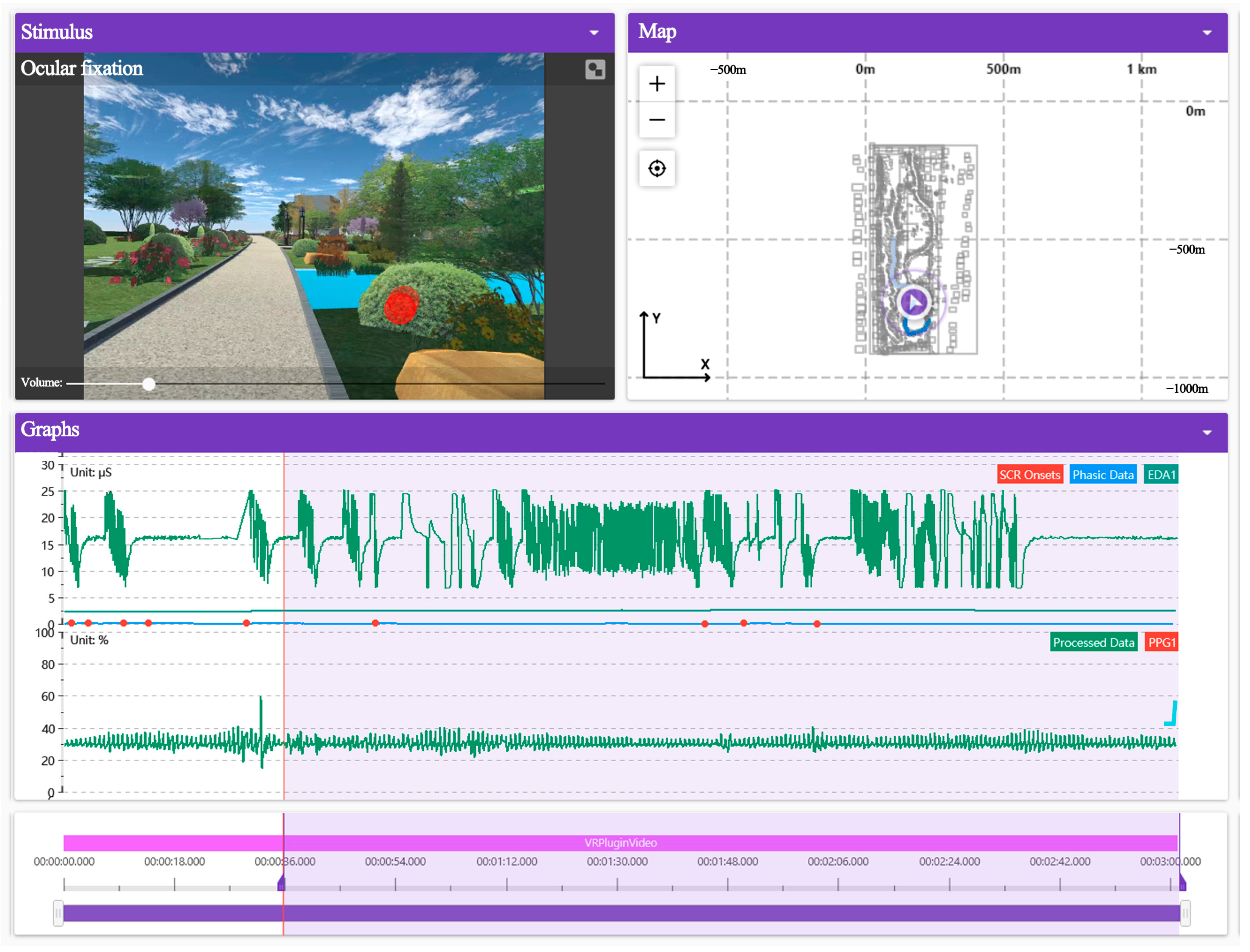
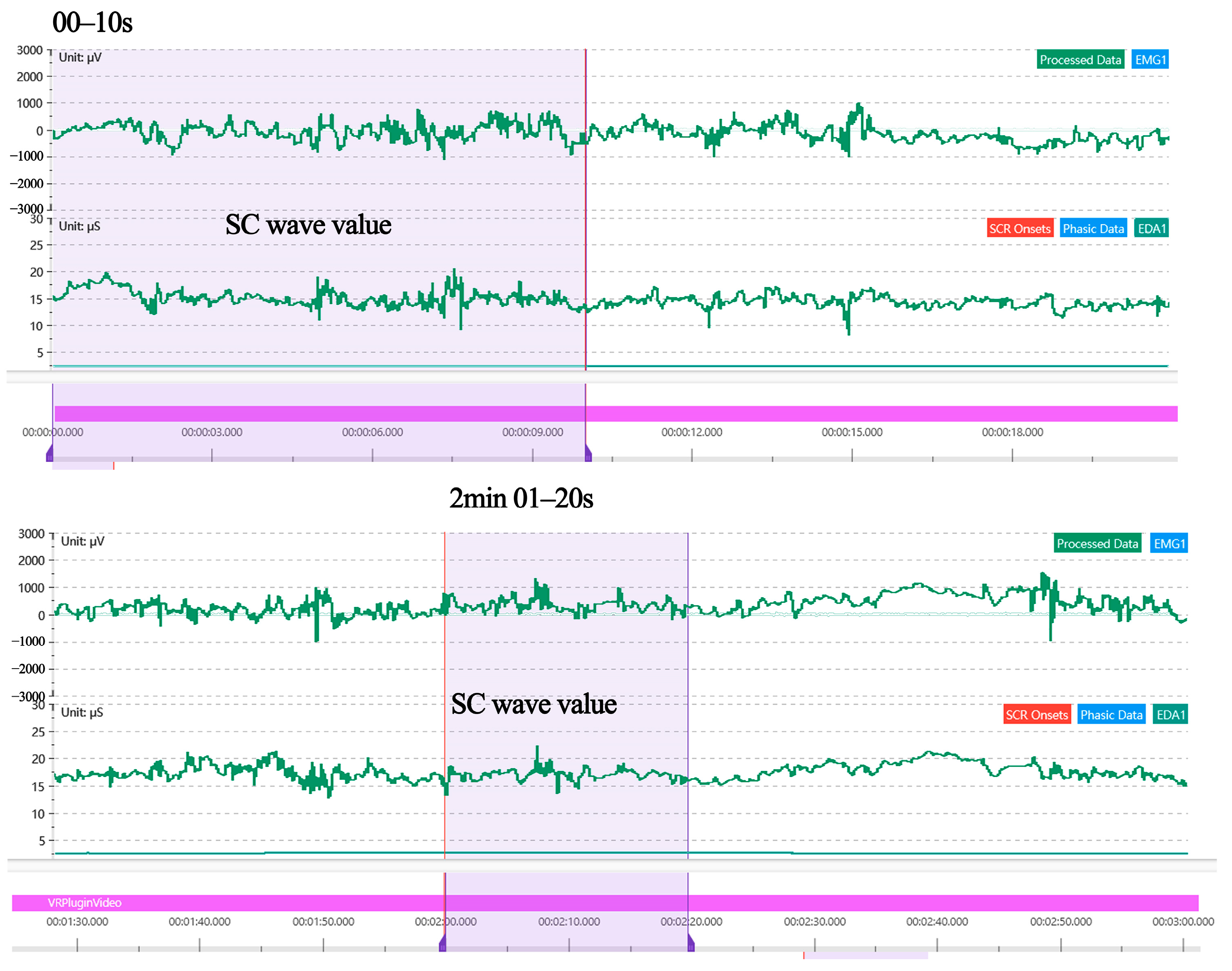

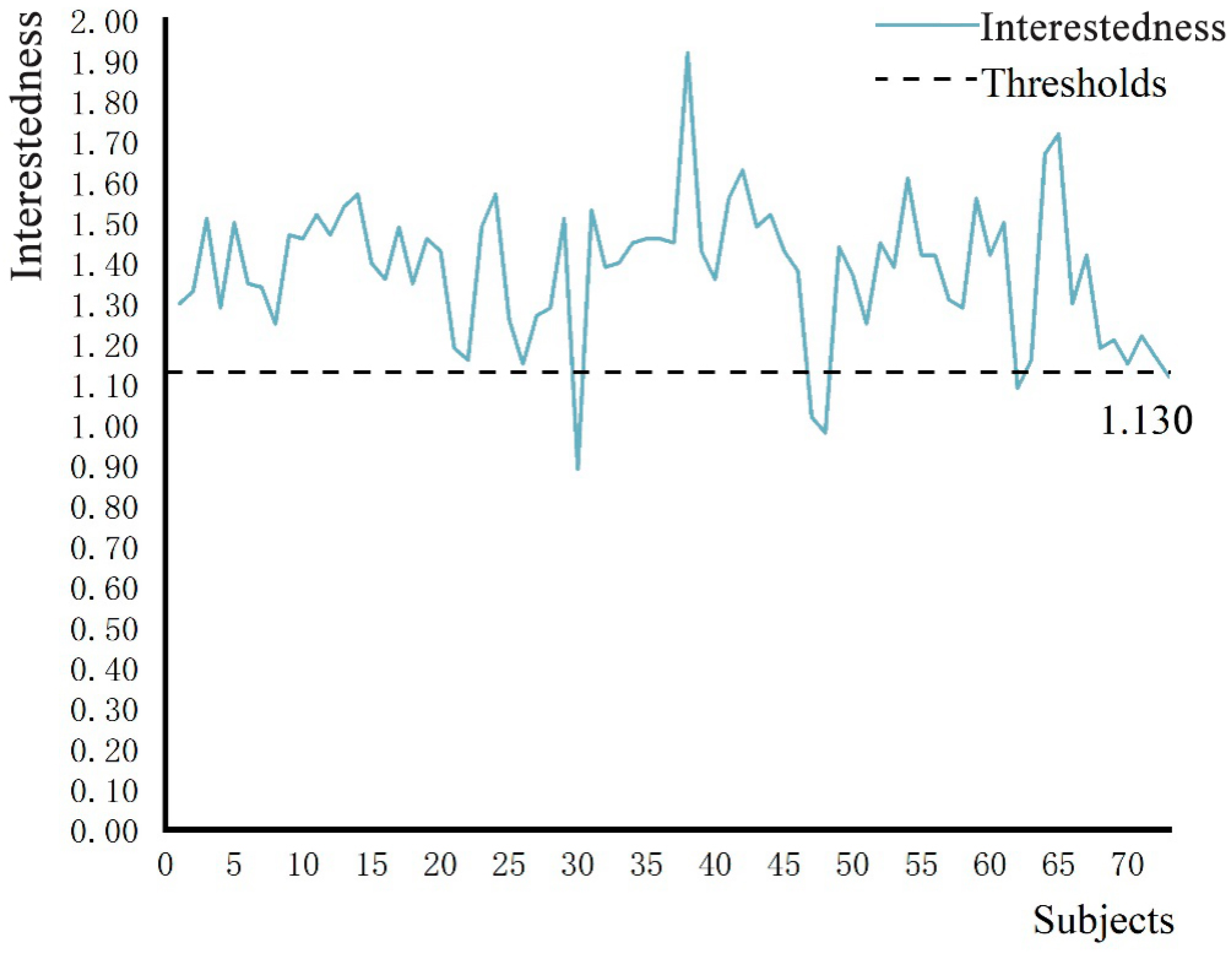
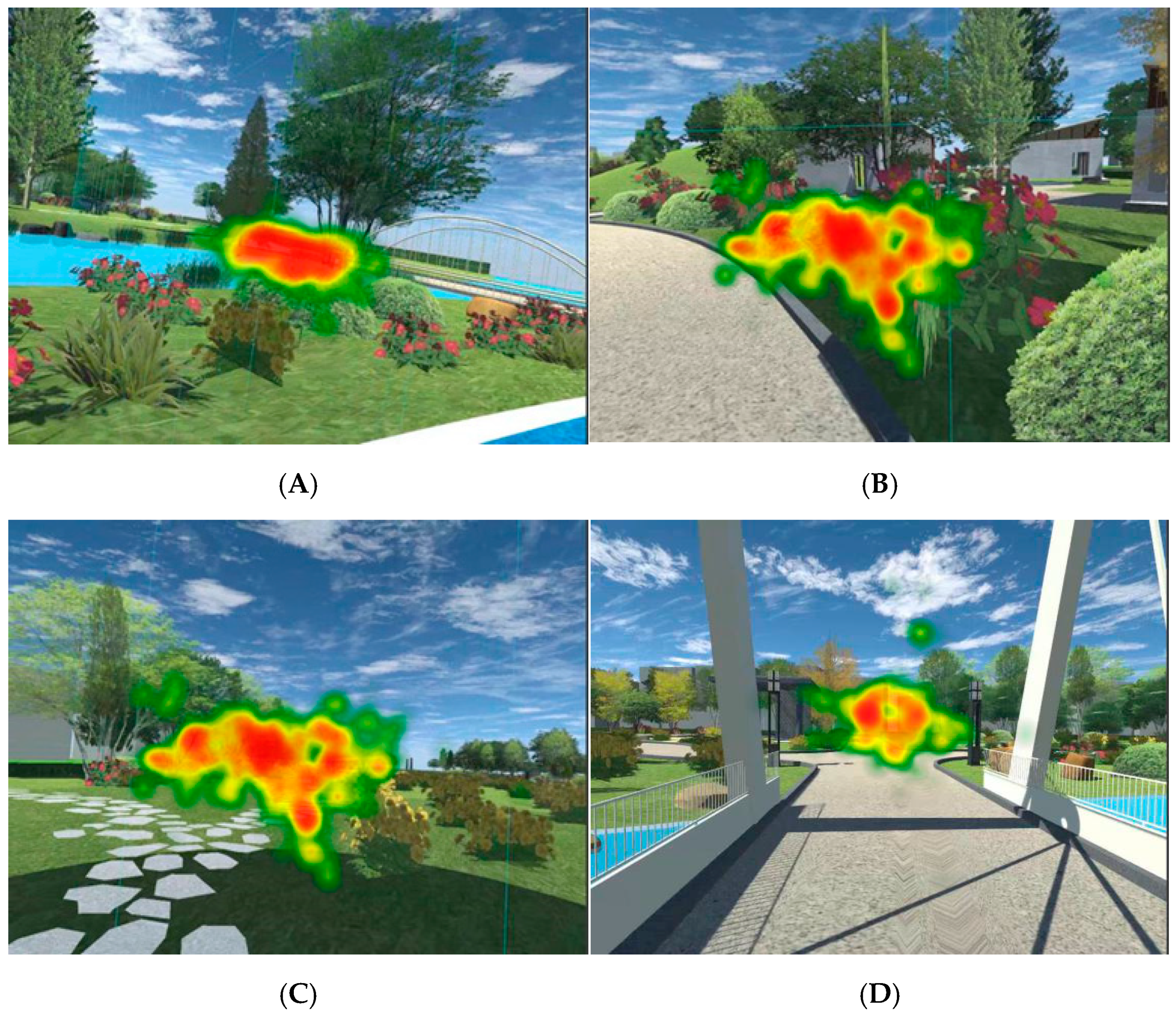
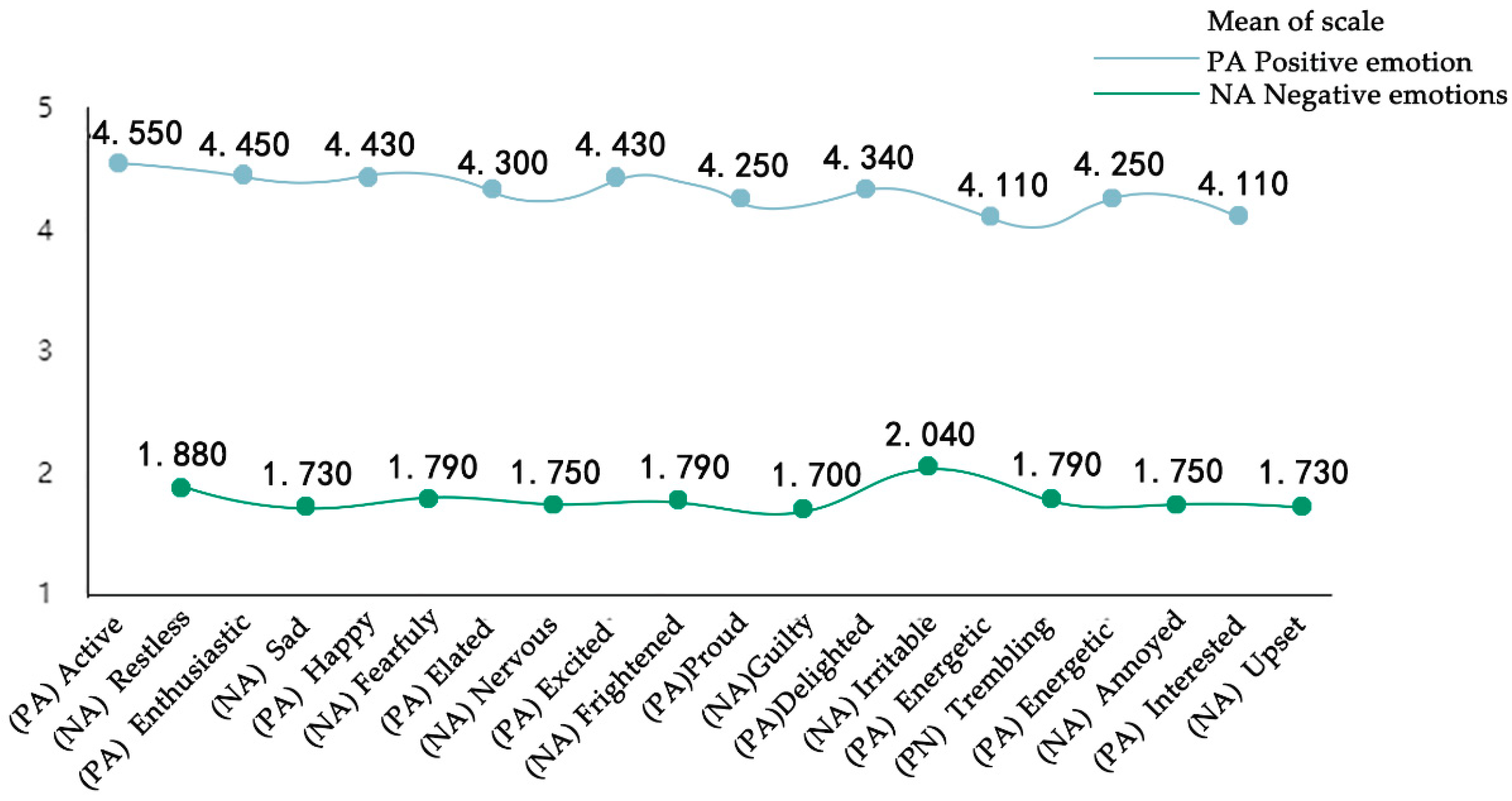
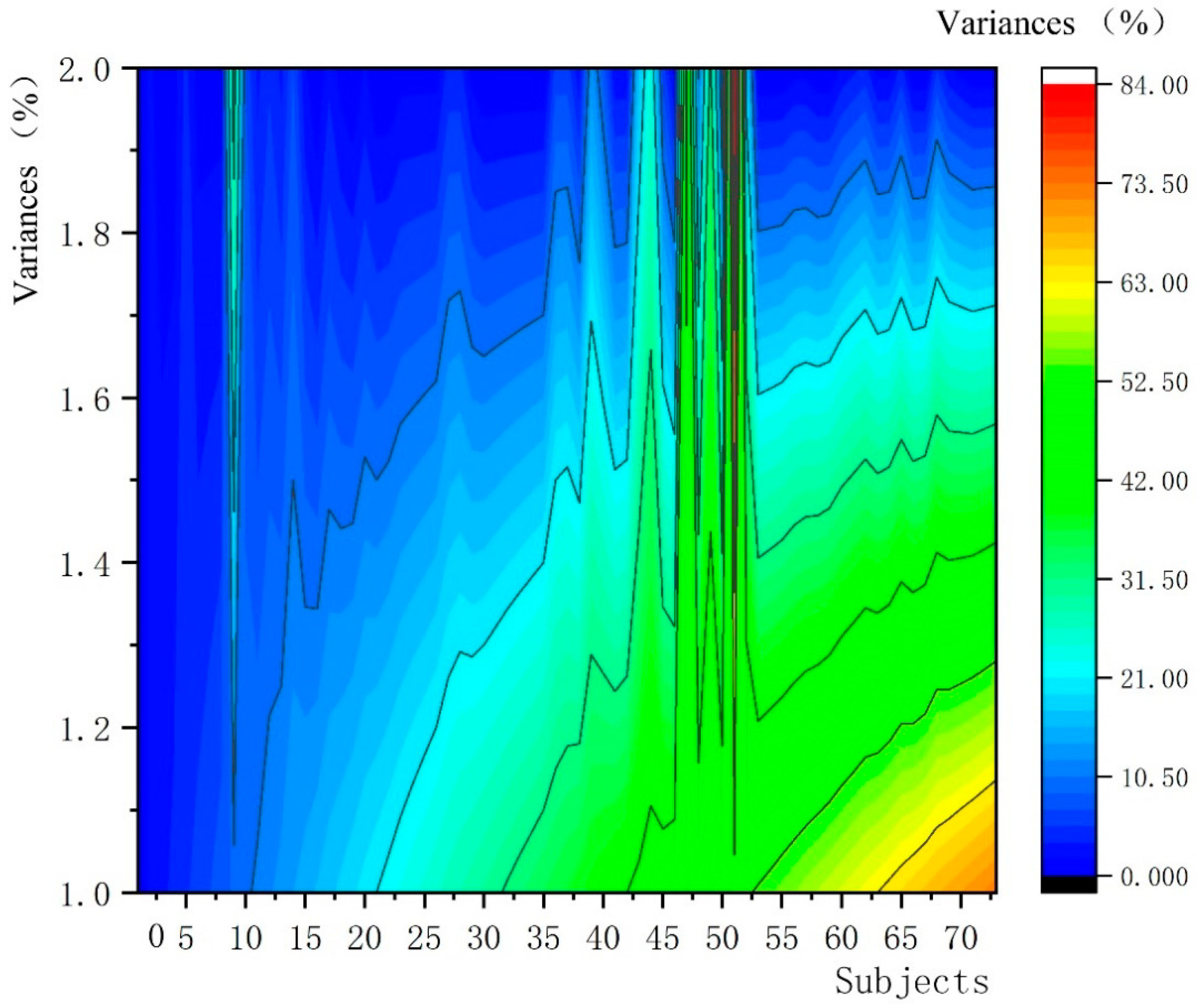
| Category of Area of Interest | Sig | p | n |
|---|---|---|---|
| Vegetation landscape | 0.038 | <0.050 | 73 |
| Flower landscape | 0.008 | <0.050 | 73 |
| Building landscape | 0.298 | >0.050 | 73 |
| Other landscapes | 0.729 | >0.050 | 73 |
Publisher’s Note: MDPI stays neutral with regard to jurisdictional claims in published maps and institutional affiliations. |
© 2022 by the authors. Licensee MDPI, Basel, Switzerland. This article is an open access article distributed under the terms and conditions of the Creative Commons Attribution (CC BY) license (https://creativecommons.org/licenses/by/4.0/).
Share and Cite
Lin, Z.; Wang, Y.; Song, Y.; Huang, T.; Gan, F.; Ye, X. Research on Ecological Landscape Design and Healing Effect Based on 3D Roaming Technology. Int. J. Environ. Res. Public Health 2022, 19, 11406. https://doi.org/10.3390/ijerph191811406
Lin Z, Wang Y, Song Y, Huang T, Gan F, Ye X. Research on Ecological Landscape Design and Healing Effect Based on 3D Roaming Technology. International Journal of Environmental Research and Public Health. 2022; 19(18):11406. https://doi.org/10.3390/ijerph191811406
Chicago/Turabian StyleLin, Zhengsong, Yuting Wang, Yang Song, Tao Huang, Feng Gan, and Xinyue Ye. 2022. "Research on Ecological Landscape Design and Healing Effect Based on 3D Roaming Technology" International Journal of Environmental Research and Public Health 19, no. 18: 11406. https://doi.org/10.3390/ijerph191811406





